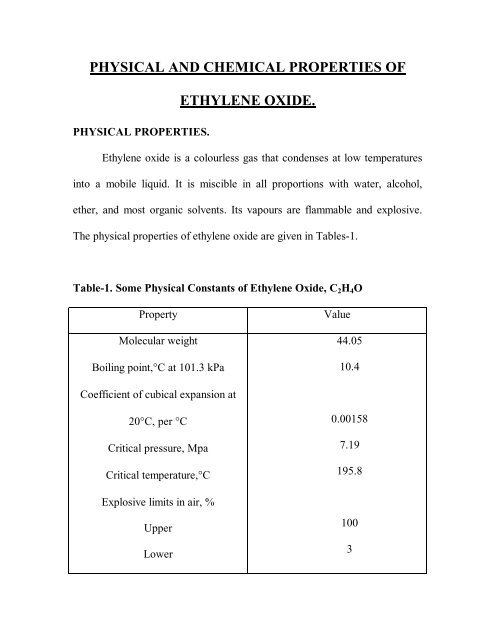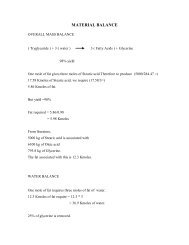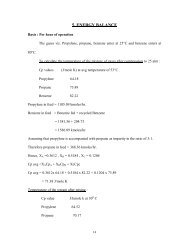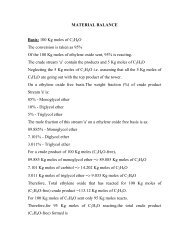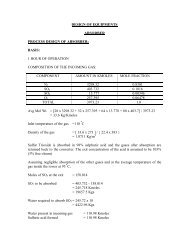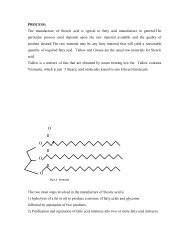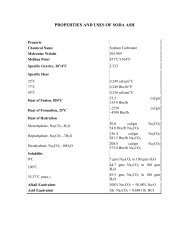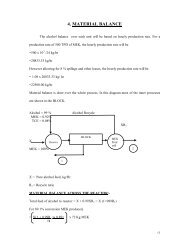PHYSICAL AND CHEMICAL PROPERTIES OF ETHYLENE OXIDE.
PHYSICAL AND CHEMICAL PROPERTIES OF ETHYLENE OXIDE.
PHYSICAL AND CHEMICAL PROPERTIES OF ETHYLENE OXIDE.
Create successful ePaper yourself
Turn your PDF publications into a flip-book with our unique Google optimized e-Paper software.
<strong>PHYSICAL</strong> <strong>AND</strong> <strong>CHEMICAL</strong> <strong>PROPERTIES</strong> <strong>OF</strong><strong>ETHYLENE</strong> <strong>OXIDE</strong>.<strong>PHYSICAL</strong> <strong>PROPERTIES</strong>.Ethylene oxide is a colourless gas that condenses at low temperaturesinto a mobile liquid. It is miscible in all proportions with water, alcohol,ether, and most organic solvents. Its vapours are flammable and explosive.The physical properties of ethylene oxide are given in Tables-1.Table-1. Some Physical Constants of Ethylene Oxide, C 2 H 4 OPropertyMolecular weightBoiling point,°C at 101.3 kPaValue44.0510.4Coefficient of cubical expansion at20°C, per °CCritical pressure, MpaCritical temperature,°C0.001587.19195.8Explosive limits in air, %UpperLower1003
Flash point, Tag open cup,°CFreezing point, °C
Clathrate formationEthylene oxide forms a stable clathrate with water. It isnonstoichiometric, with 6.38 to 6.80 molecules of ethylene oxide to 46molecules of water in the unit cell. The maximum observed melting point is11.1°C. An X-ray structure of the clathrate revealed that it is a type I gashydrate, with six equivalent tetrakaidecahedral (14-sided) cavities fullyoccupied by ethylene oxide, and two dodecahedral cavities 20-34%occupied.<strong>CHEMICAL</strong> <strong>PROPERTIES</strong>.Ethylene oxide is a highly reactive compound, and so is usedindustrially as an intermediate for many chemical products. The threememberedring is opened in most of its reactions. These reactions are veryexothermic because of the tremendous ring strain in ethylene oxide, whichhas been calculated.REACTIONSPolymerisation: The reaction of ethylene oxide with a nucleophileintroduces the hydroxyethyl group:ROH + C 2 H 4 OROCH 2 CH 2 OHThis product of this reaction can also react with ethylene oxide; if thisprocess is repeated many times, a polymer is formed:
ROCH 2 CH 2 OH + C 2 H 4 OROCH 2 CH 2 O-(CH 2 CH 2 O) n HLow molecular polymers of ethylene oxide, ploy ethylene glycol, areformed by allowing ethylene oxide to react with water or alcohols under theproper conditions. The average molecular weight can be varied from 200 to14000. Polymers with much higher average molecular weights from 90,000to 4X 10 6 are formed by a process of coordinate anionic polymerization.Crown ethers: Ethylene oxide forms cyclic oligomers (crown ethers) in thepresence of fluorinated Lewis acids such as boron trifluoride, phosphorouspentafluoride, or antimony pentafluoride. Hydrogen fluoride is the preferredcatalyst.Other reactions:1. With water:Wurtz was the first to obtain ethylene glycol by heating ethyleneoxide with water in a sealed tube. Diethylene glycol and triethylene glycolare formed as byproducts. This was the first synthesis of polymericcompounds of well- defined structure. Hydration is slow at ambienttemperatures and neutral conditions, but is much faster with either acid orbase catalysis. The type of anion in the catalysing acid is relativelyunimportant.
2. With Alcohol: These reactions parallel those of ethylene oxide withwater. The primary products are monoethers for ethylene glycol;3. With Ammonia and Amines: Ethylene oxide reacts with ammonia toforma a mixture of mono-, di-, triethanolamines. Complex compounds ofnitrogen are formed form the reaction of alkyl amines with ethyleneoxide. Diethyl amine and ethylene oxide react to yielddiethylaminoethanol.4. With phenol: The 2-hydroxyethyl aryl ethers are prepared from thereaction of ethylene oxide with phenols at elevated temperatures andpressures. 2-phenoxyethyl alcohols is a perfume fixative. The watersolublealkyl phenol ethers of the higher polyethylene glycols areimportant surface-active agents.5. With Acyl Halides, Hydrogen Halides And Metallic Halides:Ethylene oxide reacts with acetyl chloride at slightly elevatedtemperatures in the presence of hydrogen chloride to give the acetate ofethylene chlorohydrin.Hydrogen halides react to form the corresponding halohydrins.Aqueous solutions of ethylene oxide and a metallic halide can result in theprecipitation of the metal hydroxide. E.g.: The halides of aluminium,chromium, iron, thorium, and zinc in dilute solution react with ethylene


